Podcast: Play in new window | Download (Duration: 21:25 — 21.7MB)
We’re starting off October (you know, MONSTER MONTH) with accounts of animals that fall from the sky like rain, mostly fish and frogs! Is this a real thing that actually happens, and if so, what causes it?
Further reading:
Not a real photo of an octopus falling in a storm:
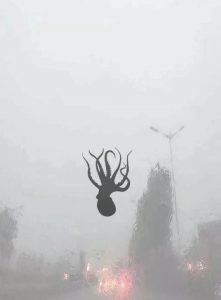
This photo is probably real, two shrimp/prawns on a windshield in the same storm as above (in 2018):
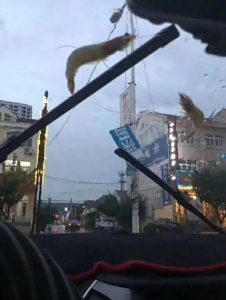
A photo of people picking up fish in the street but I have no idea where it was taken:
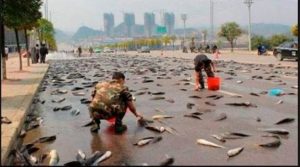
An arctic lamprey found in someone’s yard:
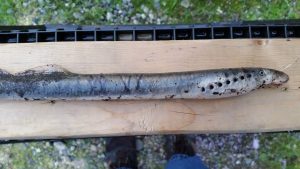
Some of the stuff called star jelly, star rot, or star snot:

A walking catfish:
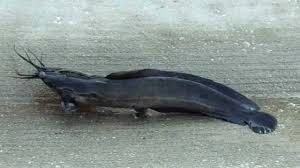
Show transcript:
Welcome to Strange Animals Podcast. I’m your host, Kate Shaw.
It’s finally October, and that means monsters and other spooky stuff! I have lots of fun episodes planned this month, but first, an important announcement!
A few weeks ago I got a message from someone on Podbean, and I feel terrible because I can’t reply or even see the whole message or who it’s from! Podbean does not like me. I get an email with the first couple of lines of the message but when I click through and log in to Podbean to see the whole message and respond, Podbean goes, “Message? What message? You don’t have any messages.” So please, person who messaged me with a suggestion I can’t see, I’d love it if you email me at strangeanimalspodcast@gmail.com! And if anyone else has ever messaged me somewhere but never received a reply, email is the best way to get hold of me. I always reply, so if you don’t get an answer it means I never saw your message and you should totally send it again. Thanks!
So, back to the October fun! Let’s start off the month right with a strange phenomenon that’s been reported for untold centuries all over the world. Do fish and frogs and other animals actually sometimes fall from the sky like rain?
It seems pretty certain that while this is a rare event, and not all reports are of animals that actually fell from the sky, it does sometimes happen. In fact, lots of weird stuff falls from the sky from time to time. For instance, after a heavy rain over Punta Gorda, Florida at the end of August 1969, the streets were full of golf balls, dozens of them if not hundreds. But there wasn’t a golf course near the town.
Sometimes colored rain falls instead of ordinary clear water. This happens because raindrops form around tiny specks of dust or pollen in the air. When the dust is colored, the rain will be too. Red rains come from dust blown into the atmosphere from the Sahara while yellow rain results from dust from the Gobi Desert. Volcanic eruptions, soot, and other pollutants in the air can cause black rain. And a red rain that fell in Kerala, India in July 2001 was analyzed and the color found to be due to fungal spores. Snow is occasionally colored too, just like rain.
But sometimes frogs, fish, or other small animals do apparently fall from the sky, with or without rain. Here’s a typical report of a rain of frogs. It comes from the book The Unexplained by zoologist Karl Shuker, whose honesty and scholarship I trust. Not only that, it’s something that happened to his own grandmother, Gertrude Timmins. In 1902, Gertrude was only eight years old. She and her mother were walking across a field in the West Midlands in England when it started to rain. They opened their umbrellas, but a moment later Gertrude noticed that amid the regular pattering of rain on an umbrella there were some heavier thumps. Then she noticed that the thumps were caused by small frogs falling onto her umbrella and bouncing off onto the ground. Gertrude was frightened at first, naturally, because that’s just a weird thing to happen to anyone. But her mother told her not to be scared, it was just a rain of frogs.
Remember, Gertrude and her mother were walking across a field. There weren’t any trees or buildings around that the frogs might have fallen from. So where did they come from?
The main hypothesis is that the animals are picked up by a water spout or small tornado and carried on the wind until they’re dropped elsewhere, miles away. When I was a kid I thought this was a dumb suggestion. If a dissipating water spout dropped everything it had picked up out of a pond, why do people just report one kind of frog falling from the sky or one kind of fish? Where’s the algae, water plants, turtles, mud, and other stuff presumably also picked up and carried out of a pond?
The answer may be pretty simple. When the wind velocity is high, the tornado or water spout can carry heavy objects, but as the wind slows and loses energy, it starts to drop the heaviest items. But the wind is still moving, so as it moves across the land and slowly loses more and more energy, it drops the heaviest items first, then the next heaviest items, then the next heaviest, and so on.
It might not even be a tornado or water spout. A powerful updraft, which is often associated with storms, can lift light items like sticks, leaves, and pool toys and drop them miles away. Small frogs often weigh no more than a penny does and during breeding season can be incredibly common in a small area, hopping everywhere. It’s reasonable to assume that sometimes these little frogs get lifted from one area by a strong updraft and dropped elsewhere, astonishing anyone who happens to see it. If you doubt the strength of an updraft, keep in mind that storms can also generate downdrafts and they can be so powerful they destroy or uproot trees.
No one has witnessed frogs or other animals get sucked up into the air and dropped elsewhere, so we don’t know if it actually happens this way. But the animals are obviously getting into the air somehow.
Frogs aren’t the only animals witnessed to fall from the sky. Fish are actually probably the most common animals that fall with rain. It doesn’t even have to be raining.
On October 23, 1947 fish fell over Marksville, Louisiana in the United States. A biologist was having breakfast with his wife in a local restaurant when the server said that fish were falling from the sky. Naturally he went to look. He identified the fish as several different freshwater species common in the area, including two species of sunfish, a type of bass, and a few others, all ranging from 2 to 9 inches long, or 5 to 23 cm. It was a foggy but calm morning with no reports of tornados or strong winds in the area.
It’s possible that a small waterspout formed over one of the many nearby lakes, sucked up whatever fish happened to be in the wrong place at the wrong time, and deposited them a few miles away. Waterspouts form the same way tornados do except that it happens over water. The inside of a waterspout, like the inside of a tornado, is a low-pressure tunnel inside a high-pressure cone of air. It acts like a vacuum cleaner, sucking up water as it moves, and anything that’s in the water near the surface gets sucked up too.
There are two types of waterspouts. Tornadic waterspouts are tornados that happen to touch down over water instead of land. They can be dangerous and are usually reported in the local news and weather if they’re spotted. But fair-weather waterspouts aren’t associated with storms, although they do form ahead of developing storm systems. They’re typically smaller, much less dangerous, and much less likely to be reported to the news. So it’s possible that the 1947 fish fall was the result of a fair-weather waterspout.
This phenomenon isn’t something that used to happen in the olden days and doesn’t happen now. In June of 2009, there were tadpole rains in parts of Japan on two different days in slightly different areas. One man saw over a hundred dead tadpoles on car windshields in one parking lot after a rain shower.
On June 13, 2018, shrimp and possibly other sea creatures fell on the coastal city of Qingdao [zhing-daugh], China during a storm. The media reported it as a “seafood rain” since people posted photos of octopus, squid, starfish, mollusks, and shrimp that they claimed had fallen during the storm. Some of the photos are hoaxes, especially the ones of octopuses flying through the air, but at least some of them are real. Some people speculate that the source of the animals may have actually been a market stall, but since the city is on the coast of the Yellow Sea and the storm’s winds were measured at 77 mph, or 125 km per hour, it’s just as likely that the animals were lifted into the air from shallow water as from a market stall.
Sometimes we can figure out what the cause is of falling animals. In 2015 the Alaska Department of Fish and Game received four separate calls from people who’d found arctic lampreys on their property, including the parking lot of a store and someone’s front yard. If you remember from waaaaay back in episode 3, where we talked about the sea lamprey, lampreys are jawless fish with suckerlike mouths. They latch onto a fish and use their rasping teeth to parasitize it. The arctic lamprey grows to about a foot long on average, or 30 cm, but occasionally one will grow twice that long. It lives in cold freshwater lakes and rivers in the arctic, although it’s found as far south as Japan. An investigation revealed that all four lampreys found on land had cut marks and bruises in a specific pattern, which indicated that they’d been picked up in the beak of a seagull and then dropped, probably by accident when the lamprey wriggled too much. In 2015 there were an unusually high number of arctic lampreys in the Chera River, near where the four lampreys were reported on land.
A substance often referred to as star jelly or star rot has been seen in various parts of the world for centuries, usually connected in folklore with comets and shooting stars. In late 2008 through February 2009 the BBC’s Scotland Outdoors website collected photos and accounts of star jelly people had encountered in Scotland and other places. People reported finding lumps of the usually clear or white, jelly-like substance in their gardens, on walkways, on fence posts, stumps lawns, on the side of the road, in pastures, on rocks, and so on. One person found a lump of it on his tractor, another on a 3rd floor balcony.
Even hundreds of years ago some people suspected star jelly had something to do with frogs. At least some of it looks like the jelly-like matrix that surrounds the eggs of many frog and toad species. This is backed up by the presence of small black eggs in some star jelly that look like frog eggs. But it’s clearly not exactly frog spawn and is often found in places where a frog would never lay its eggs, even if it could for instance get up onto a third floor apartment balcony.
Many samples of star jelly have been examined by scientists and found to be the spawn jelly of frogs and toads, which is produced by the female to surround the eggs and keep them damp. As the female lays her eggs, each one is coated with a layer of spawn jelly, which absorbs water in the environment and increases in volume. Sometimes when a predator tears a frog or toad into pieces to eat it, the reproductive tract is torn open and its contents falls to the ground. When the spawn jelly is exposed to the air, it starts to absorb moisture from whatever it’s touching. This will make it swell up and become much more noticeable to people, especially if it’s rained and the spawn jelly has absorbed a lot of water.
Often an animal will eat a frog or toad, then later regurgitate the less digestible parts. This includes spawn jelly and some parts of the reproductive tract, specifically the oviducts since they contain the spawn jelly. Sometimes eggs are mixed in too. Star jelly has been examined and tested frequently, although most DNA testing has been inconclusive since samples are contaminated with bacteria. But a 2015 DNA test determined that the star jelly was from a frog. The test also found traces of magpie DNA, so we can probably guess what ate the frog.
Some star jelly doesn’t have anything to do with amphibians, though. Instead, some are slime molds or a type of freshwater algae-like bacteria known as nostoc. Neither slime molds nor nostoc fall from the sky but they can appear suddenly, so people may assume that’s what happened. Many birds that eat frogs and toads will eat them in midair, and may also regurgitate the indigestible portions while flying, so at least some star jelly does fall from the sky.
Sometimes people assume an animal has fallen from the sky when it actually hasn’t. For instance, the walking catfish will wriggle across dry land to find water when its pond dries up. It can grow up to 1 ½ feet long, or half a meter, and is usually grayish-brown with little white spots. Its skin is covered with mucus that helps keep it from drying out when it’s out of water. It’s native to parts of Southeast Asia, but it’s been introduced to other places, including southern Florida. In places where it’s not native, people may not be familiar with its ability to breathe air and move around out of the water, so when they see the walking catfish on land they may assume it fell from the sky.
The walking catfish is an invasive species in many areas. It’s an omnivore and can tolerate all kinds of habitats, including stagnant water where other fish can’t survive, since it can breathe air. Fish farmers in areas where the walking catfish lives have to put fences up around their ponds to keep walking catfish out. And if you see one, don’t pick it up. Its fins have spines that help stiffen them so it can use them to move more effectively on land, but that make them sharp.
We obviously don’t know everything about animals that fall from the sky, so let’s finish with a real mystery. It’s called the Kentucky Meat Shower and it happened on March 3, 1876 in a tiny community called Olympia Springs, Kentucky.
Olympia Springs is east of Lexington, Kentucky, in the southeastern United States. These days it’s in the Daniel Boone National Forest and just outside of the Olympia State Forest, so there’s not much in the area except wilderness. This was probably also the case in 1876 except that in 1876 there probably wasn’t a Dairy Queen restaurant a ten minute drive away. Wikipedia says it happened in a community named Rankin in the same county, but most other sources say Olympia Springs. Either way, it was an isolated, remote area at the time.
On this particular day, a woman only identified as Mrs. Crouch was in the yard, making soap. It was a perfectly clear day, not a cloud in the sky, when suddenly it started raining meat. She said it fell like big snowflakes all around her, but presumably not as pretty as snow, and lasted for several minutes. It was fresh meat, looked like beef or other red meat, and the pieces were irregularly shaped and gristly. Some were as big as 4 inches across, or 10 cm, but most about half that size. The meat landed all around, including on fences, in an area estimated to be about 100 yards across and 50 yards wide, or 91 by 46 meters.
Mrs. Crouch and her husband were understandably shaken by this event, and records don’t report whether the soap got finished that day but I suspect not. The next morning, the meat was still lying around, but it had dried out overnight and was starting to spoil. A couple of men stopped by and actually tasted it—ugh, I hope they at least cooked it first—and said they thought it might be venison or mutton. That’s meat from deer and sheep, respectively.
Samples of the meat were sent to various experts who examined it. Keep in mind that this was 1876 so they couldn’t do much more than look at it under an old-timey microscope. Two samples were identified as lung tissue, two as cartilage, and three as muscle.
As soon as the story hit the newspapers, people were quick to offer solutions that didn’t actually fit the reported facts. One person suggested that it was just nostoc that hadn’t actually fallen from the sky, it had been on the ground all along but that rain had made it swell up, which is something nostoc does. Never mind that nostoc is a slimy bacteria that looks nothing like meat—remember, it’s sometimes identified as star jelly—and that it wasn’t raining at the time and that Mrs. Crouch actually saw it fall and that pieces of it were found draped over fences. Plus, nostoc doesn’t taste like venison or mutton. Plus, samples were identified as actual meat.
The main suggestion is that some vultures were flying overhead and had disgorged some meat they had eaten, which had been caught by the wind and fell across a wide area. But while even nowadays people claim that is what must have happened, it has one big flaw. Vultures don’t disgorge meat while they’re flying. They disgorge it as a way to deter predators approaching their nest, and they may disgorge if a predator approaches while they’re feeding so they can get into the air quickly, but not while flying. Not only that, but any meat disgorged by a vulture would smell and taste horrible, since it would have already been rotting before the vulture ate it, and it would then be coated with caustic vulture digestive juices.
So what might have caused the Kentucky Meat Shower? If it wasn’t a newspaper hoax, which were really common in the late 19th century, it might have been the result of some poor animal that was swept up by a tornado, torn apart, and the smallest pieces dropped over the Crouch’s farm after the winds had dissipated. Presumably the heavier pieces, like bones, fell earlier and probably landed in the forest where no one saw them fall. I looked for a weather report for Kentucky for that day, but couldn’t find one. Eastern Kentucky is not too far north from where I live in East Tennessee, so I can verify that March can be a very warm month with unsettled weather. It wouldn’t be at all unusual to have a storm strong enough to generate a small but powerful tornado in March, although this usually happens at night after a hot day.
I don’t know if I believe the Kentucky Meat Shower really happened or if it was a hoax. But either way, we can stop blaming vultures.
You can find Strange Animals Podcast online at strangeanimalspodcast.blubrry.net. That’s blueberry without any E’s. If you have questions, comments, or suggestions for future episodes, email us at strangeanimalspodcast@gmail.com. We also have a Patreon if you’d like to support us that way.
Thanks for listening!